14
After testing, the cream was strained into a holding tank, where it was kept chilled, then pumped via an overhead feeder pipe to the four, and later seven, pasteurizers which were lined up side by side. Steam, heated in the early days by coal and later by oil, passed through the cylinders inside the pasteurizers, heating the cream to over 170 F . It was held at this temperature for 10 to 15 minutes, and then cooled quickly to 40 F by passing ice cold water through the cylinders. Pasteurizing was necessary to kill harmful bacteria in the cream. The pasteurizing process usually took place in the afternoon, ready for the cream to be pumped to the butter churn the next morning.15
Butter churn20th century
The Tatamagouche Creamery, Creamery Road, Tatamagouche, Nova Scotia, Canada
 Credits:
Credits:Skyline Atlantic Canada
Creamery Square Heritage Centre
16
In the early days the butter churn at the Creamery would probably have been made of hardwood. However, by the 1950's a stainless steel churn was used. In the late 60's and early 70's the day started at 7:30 or 8:00 AM, with the cream being passed along pipes from the pasteurizer to the churn. It took about two hours to churn a load of butter with three to four churnings a day, which produced some 4200 - 4800 lbs of butter and five to six churnings produced 6000 - 8000 lbs. Austin Creighton, son of J.J. Creighton, estimated that in its 67 years of operation, the Creamery produced 25000 tons or 50 million lbs of butter.As the cream was churned into butter salt was added, with more salt added to make 'extra salt' style butter. For every 1400 gallons of cream 14 lbs of salt and 14 lbs of water were added. The churn had a capacity of 2000 gallons but worked better with 1400 - 1500 gallons, producing about 60,000 lbs of butter a month. It was thoroughly cleaned after each use to prevent possible contamination from a previous batch. Cattle who fed on grass produced the best coloured butter in the summer, so often colouring was added to batches of butter made during the winter months. In addition, during winter care was needed to ensure that cattle had not been fed too many turnips as it flavoured the butter! Often when supplies of cream were lower during the winter, butter was brought in from other provinces, Australia and New Zealand in 56 lb blocks. These were cut into smaller pieces and added to the local butter and re-churned.
The water content was carefully checked; 16.5% was permissible in regular butter, 15.5% in extra salt. Surplus water was drained off. Inspectors visited the stores and the Creamery to check on the water content in the butter; if a batch in a store had too much water the butter was returned to the Creamery for re-churning.
17
Emptying the butter churn20th century
The Tatamagouche Creamery, Creamery Road, Tatamagouche, Nova Scotia, Canada
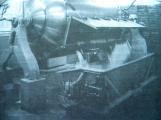 Credits:
Credits:North Shore Archives
18
Moving butter from the churn onto the butter table20th Century
The Tatamagouche Creamery, Creamery Road, Tatamagouche, Nova Scotia, Canada
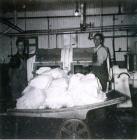 Credits:
Credits:North Shore Archives
19
The butter was at one time scooped from the churn with paddles onto a wood table with wheels. This was later replaced by the butter boat or bath. The butter bath was then moved to the printer machine where the butter was shaped and wrapped for shipping. The bath eventually had a hydraulic system that raised and lowered it, making it easier to get the last of the butter out of the churn. The butter was shovelled into the receiving tank of the printer where worm screws started to work, pushing the butter toward the printers where it was shaped.20
Butter paddle20th century
The Tatamagouche Creamery, Creamery Road, Tatamagouche, Nova Scotia, Canada
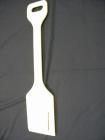 Credits:
Credits:Creamery Exhibit, Creamery Square Heritage Centre
21
The early butter paddles were made of hardwood, maple in particular. Burton Watt of River John, Nova Scotia, designed a hardwood butter paddle with a d -shaped handle, which made the shovelling easier. For a short time, smaller, metal paddles were tried. However, they had quite small 'heads' and were made of highly polished metal which caused the butter to slip too easily off the paddle, with frustrating results. When plastic became available, paddles such as the one pictured here were introduced. This paddle is approximately 40 inches long and surprisingly heavy.22
The butter printer20th century
The Tatamagouche Creamery, Creamery Road, Tatamagouche, Nova Scotia, Canada
 Credits:
Credits:Creamery Exhibit, Creamery Square Heritage Centre, Tatamagouche
23
Inside the printer the two horizontal worm screws moved the butter forward and then a vertical screw pushed it into the block or print maker. Originally butter was pressed into the moulds by hand, and the top scraped smooth. Butter worked into the hands was a good 'hand cream' but it had a lingering smell which was noticeable when workers were elsewhere in the village! The mechanized printer shaped butter into blocks or 'prints' which were then moved on a rotating surface into the reach of the automatic wrapper. Here a mechanical 'arm' moved over, picked up a wrapper and slapped it on the butter and wrapped it. The wrapped butter was then stamped with the date and batch number before finally passing on to the short conveyor belt. The prints of butter were carefully lifted by hand and placed in wooden, or later cardboard, boxes which were then sent out to stores or put in the coolers at the Creamery. The coolers were added in the early 1960's according to a letter from J.J. Creighton to Cecil Langille, written May 10 1962, " . . . the installation of the cooling unit is almost completed and we hope to have it in operation next week."24
The butter printer20th century
The Tatamagouche Creamery, Creamery Road, Tatamagouche, Nova Scotia, Canada
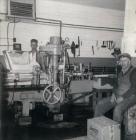 Credits:
Credits:North Shore Archives
25
Former employee Raymond Lewis recalls packing the freshly wrapped butter as it left the printer. He said that he used both hands rhythmically, switching from his left hand to his right hand, and carefully lifted the prints and placed them two at a time into a 56 lb wood box. The butter tended to be soft so care was necessary. He also had to make sure the wrapper was well fixed in place, otherwise the butter could leak. Raymond recalled that one the of the two cooling rooms contained a large crock of buttermilk which was sold to the public in 2 gallon jugs, in addition to the stores of butter ready to be shipped. Once in the coolers, the packs of butter would eventually be moved to a waiting truck, through' windows' at the back of the cooler, These 'windows' were of wood, so that when closed the room remained cool.26
Wrapped butter prints leaving the printer20th century
The Tatamagouche Creamery, Creamery Road, Tatamagouche, Nova Scotia, Canada
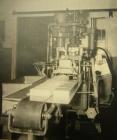 Credits:
Credits:North Shore Archives